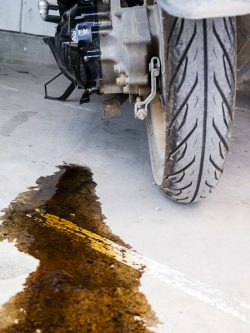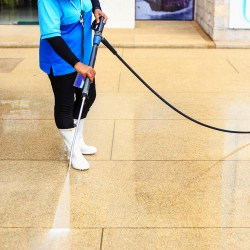Grease and oil stains on concrete driveways, in a garage with concrete flooring, or parking areas, are an eyesore. According to the Concrete Institute, although most common oil stains can be difficult to remove because of their rapid absorption into the concrete, there is a solution.
 The most important action that can be taken is to stop the stain from spreading. Mop up as much of the stain as possible with paper towels or cloths, blotting rather than wiping, and then generously sprinkle and cover the entire stain with the fine material.
The most important action that can be taken is to stop the stain from spreading. Mop up as much of the stain as possible with paper towels or cloths, blotting rather than wiping, and then generously sprinkle and cover the entire stain with the fine material.The Concrete Institute shares some guidelines on how to deal with this problem.
Test the cleaning method
Firstly, before attempting to remove any stain, an inconspicuous place should be treated first to assess the effect the cleaning method will have on the concrete. You don't want to spend too much time and effort on removing stains that have been absorbed too deep into the concrete.
Stop the stain from spreading
The most important action that can be taken is to stop the stain from spreading. To do this, sprinkle a fine, dry material like sand, sawdust or cat litter over the stain. Mop up as much of the stain as possible with paper towels or cloths, blotting rather than wiping, and then generously sprinkle and cover the entire stain with the fine material. Use a soft broom to sweep this back and forth over the stain before removing it.
Oil removing agents
When it comes to removing greasy stains, the Concrete Institute recommends using automotive engine degreasers, high-foam washing powder or concentrated liquid detergents.
 When it comes to removing greasy stains, use automotive engine degreasers, high-foam washing powder or concentrated liquid detergents.
When it comes to removing greasy stains, use automotive engine degreasers, high-foam washing powder or concentrated liquid detergents.How to remove oil stains
These products are more effective when mixed and applied with boiling water. A stiff bristle brush, although useful for removing thick surface oil deposits, is inadequate for reaching deposits that have already penetrated into the pores of the concrete.
Use a high-pressure washer instead as it is effective in removing ingrained stains. The high pressure cleaner should be used after the cleaning agent has been applied but before it has evaporated. For this reason, application of the cleaning agent in direct sunlight is not recommended.
As soon as the oil or grease deposit has been removed, the entire area should be flushed with clean water to prevent soiled water re-depositing the oil onto any adjacent concrete.
 The high pressure cleaner should be used after the cleaning agent has been applied but before it has evaporated.
The high pressure cleaner should be used after the cleaning agent has been applied but before it has evaporated.Be careful when using a high-pressure washer on concrete that is flaking or breaking up. Wear protective clothing and goggles to guard against rebounding grit coming from displaced material from the concrete or between block paving.
Once most of the surface stain has been removed, cover the residue with a poultice made up of one part agricultural lime to two parts mineral turpentine. Spread a layer of about 5mm of the paste over the stained area, ensuring that there is a margin of approximately 50mm to 100mm around the edges. Cover the plastic sheeting and leave for 24 hours. Builders’ lime should not be used as it could cause skin burns.
It may be necessary to repeat this process within a day or so to remove any deeply ingrained oil or grease that sometimes continues to rise to the surface.
Finally, scrub the stained area with warm water and laundry detergent, then rinse well with clean water to end the treatment.
Article courtesy of www.home-dzine.co.za.









